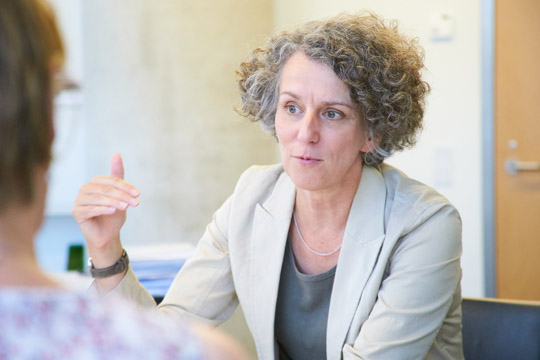Disruptive Factors in the Information Supply
Freiburg, Jul 30, 2018
Even though they cannot be found in databases of serious journals, companies like to refer to websites that quasi-scientifically confirm the effects of their products: what are known as “predatory journals” – examples include Waset and Omics – are now not just an issue for the scientific community. These fraudulent organizations bypass standards such as peer review and feign scientific integrity. Annette Hoffmann spoke with Dr. Antje Kellersohn, Executive Director of Freiburg University Library, and with the mathematician and biometrician Prof. Dr. Gerd Antes. As the Scientific Director of the foundation Cochrane Deutschland Stiftung, Prof. Dr. Antes has been studying the subject for years and in addition provided scientific advice to the ARD documentary “Fake Science. Die Lügenmacher”.
 Photo: BillionPhotos/Fotolia
Photo: BillionPhotos/Fotolia
Ms. Kellersohn, why are predatory journals an issue for you as the director of a university library?
Antje Kellersohn: Scientific journals in the proper sense of the term are a vital cornerstone: they are essential to research and teaching. The central role of a university library is to ensure an appropriate supply of information for members of the university. When selecting and providing journals we place great value on an established quality assurance procedure, such as peer review. We take care not to spend any money from our budget for literature on predatory journals. And that applies to our open access publication fund too of course.
Gerd Antes: Predatory journals are a very special issue, because in what is a generally positive and profound restructuring they are a disruptive factor: until now, reading scientific journals was paid for by subscriptions or other methods. This model is being superseded; in future, writing the articles and producing the journal will be financed. So use will become free. This creates new openings that the predatory journals have assailed with force.
Kellersohn: Currently, reporting lumps everything together, and various aspects must be differentiated. On the one hand there is the distribution of untrustworthy, sometimes fabricated information in predatory journals, to give these journals a supposedly scientific appearance. This is illegal and unethical. On the other, it has become apparent that some academics routinely publish in such journals, for instance to avoid the lengthy review process. This is extremely dubious conduct, even if there is nothing wrong with the actual content of the article.
 Gerd Antes holds researchers responsible: “Experienced authors with more than one publication in such journals have a lot of explaining to do.”
Gerd Antes holds researchers responsible: “Experienced authors with more than one publication in such journals have a lot of explaining to do.”
Photo: Harald Neumann
Media report a dramatic rise of around 40 per cent in publications in predatory journals.
Kellersohn: This is a worrying trend. But to help explain things, let me give you a few figures. In 2016 alone we recorded 4,000 articles by Freiburg academics in trustworthy specialist journals, and twenty per cent of these had open access publication. Just two Freiburg academics published in Omics – so that puts us in the tenths of a percent range. Worldwide it is estimated that articles in predatory journals make up a share of up to two per cent. So they are isolated cases, nevertheless we have to observe this development and counter it.
Antes: I’m not so tolerant about this. Feigning naivety is an easy way out. I’d accept naivety from junior researchers, but that means that the established researchers are failing in their supervisory role. Experienced authors with more than one publication in such journals have a lot of explaining to do.
How can academics identify the black sheep?
Kellersohn: Researchers who have been affected report that articles are accepted and released without any revision, before the authors have even released the texts. When the invitation to publish comes – often by e-mail – there is no mention of costs, then the invoice comes later. This is clearly embarrassing to many of those affected, yet it is important to make it public. We recommend consulting a whitelist such as the Directory of Open Access Journals if in doubt. This only lists titles with an established quality assurance procedure.
Can universities and the scientific community solve the problem themselves, or must politicians take action?
Antes: The real problem is that we have the wrong reward mechanisms in the universities. Too often we reward quantity over quality. Limiting oneself to a small number of relevant publications instead of 25-page lists tends to be the exception to the rule. And that’s not just the case for individual careers, but also for institutions. In medicine we have performance-related funding, and the amount of publications is a crucial factor in this. It is being measured by the impact factor which has been criticized for years. This only creates a climate in which quantity counts.
Kellersohn: With luck, the current discussion will damage business for the operators of these journals. But there have always been fraudulent aberrations and forgeries in the world of publication, and that won’t change in the future. However, I find the claim that’s now being made in this context that switching to open access is the cause of the problem is a worrying one. In our negotiations with the publishers Elsevier, Springer Nature and Wiley as part of the DEAL project, we aren’t just asking for publications by academics from Germany to be made open access, but also that there is systematic continuation of the established quality assurance.
 “Freiburg University Library has already begun to incorporate the issue in its established teaching and advisory services, to provide informational skills to students and junior researchers,” says Antje Kellersohn.
“Freiburg University Library has already begun to incorporate the issue in its established teaching and advisory services, to provide informational skills to students and junior researchers,” says Antje Kellersohn.
Photo: Harald Neumann
Why is it so hard these days to identify a lie as such?
Antes: I now talk about a “Trumpization” in science. This zeitgeist – and Donald Trump is just a symptom – can also be found in science. Even if it’s just two percent. We need public funding to give researchers guidance in the form of whitelists of journals – and possibly also blacklists. And then institutions must monitor that these standards are upheld.
Kellersohn: We have to develop counter-strategies based on detailed studies into the development of predatory journals and their use. However, I am critical of blacklists. Freiburg University Library has already begun to incorporate the issue in its established teaching and advisory services, to provide informational skills to students and junior researchers. We’re also preparing some exciting courses on the subject for the coming winter semester.
ARD documentary “Fake Science. Die Lügenmacher”
Interview with Antje Kellersohn on the Project DEAL negotiations
Recognizing Predatory Journals
See through the fraudulent practices of ostensibly scientific publishers: Freiburg University Library (UB) has compiled information on its website on how to recognize untrustworthy or dubious journals.
More information

